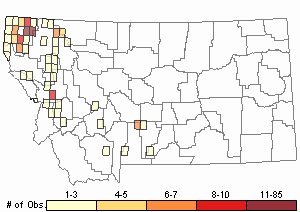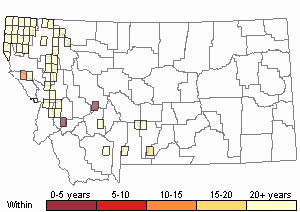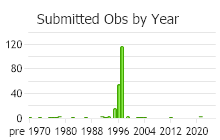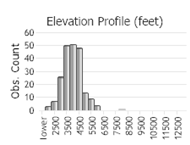View in other NatureServe Network Field Guides
NatureServe
Montana
Utah
Wyoming
Idaho
Wisconsin
British Columbia
South Carolina
Yukon
California
New York
A Dicranum Moss - Dicranum tauricum
General Description
Plants: Growing in crowded clumps of erect shoots, shiny, pale- to yellow-green (FNA 2007) above, olive green to brown below (Flowers 1973). Stems 5-30 mm tall (FNA 2007), branched, possessing a central strand (Flowers 1973); rhizoids pale or russet, covering the stem with woolly matting (FNA 2007).
Leaves: Spreading to ca 45 degrees, similar in dry or moist condition (FNA 2007) or leaves more upright when dry (Lawton 1971), the majority of leaf tips falling away and missing, lance-shaped, 4-6 mm in length, 0.4 mm or less in width, cupped below, tube-like above to an acute leaf tip (when present), smooth; margins sometimes saw-toothed apically; costa extending well beyond the stem, lacking dorsal crests (FNA 2007).
Leaf Cells: Lamina of 1 layer of cells, or sometimes areas with 2 layers in the apex; walls between the cells not protruding; upper laminal cells square, short and quadrangular, the angles sometimes smoothed, not porose (FNA 2007); lower laminal cells long (Lawton 1971) and very thin to quadrangular, slightly porose (FNA 2007); alar cells distinct, reddish, strongly swollen and forming auricles (Flowers 1973), not reaching the nerve, the alar region 1 cell-layer thick; costa in X-section with guide cells in 1 row, both stereid bands absent, cells with big lumens and somewhat wider walls adjacent to the guide cells in 1 or 2 rows, the ventral and dorsal superficial layers not distinct (FNA 2007).
Phenology
Fruit ripens in summer (FNA 2007).
Diagnostic Characteristics
Broken leaf tips lend a distinctive appearance to both D. tauricum and Dicranum fragilifolium, another species with fragile leaves, causing confusion where their ranges overlap. The capsules of D. fragilifolium are usually bowed; those of D. tauricum are straight. In sterile plants, check the X-section of the costa in the proximal half of the leaf. In D. fragilifolium, stereid cells occur in two narrow bands; there are none in D. tauricum (FNA 2007).
Range Comments
North American Range
AK, NT, BC to SK and s to CA, UT, CO, and NE (except unknown in ND) (FNA 2007). Known in MT from Carbon, Cascade, Flathead, Gallatin, Glacier, Granite, Lake, Lincoln, Madison, Mineral, Missoula, Powell, Ravalli, Sanders, Sweet Grass, and Valley Counties (Elliott 2016).
Observations in Montana Natural Heritage Program Database
Number of Observations: 265
(Click on the following maps and charts to see full sized version)
Map Help and Descriptions
Relative Density

Recency



 (Observations spanning multiple months or years are excluded from time charts)
(Observations spanning multiple months or years are excluded from time charts)
Habitat
Epiphytic (Vitt 1988), often on decaying wood and bottoms of tree trunks, occasionally humus overlying stone or just humus; mostly in shaded areas (Flowers 1973). Elevation: 490-7220 feet (FNA 2007).
Reproductive Characteristics
Dioicous. Inner perichaetial bracts enveloping the stem, slowly tapering to a subula. Seta single, ochre to yellow, 15-25 mm tall. Capsule vertical, not bowed, 1.4-2.5 mm in length, erratically creased when dry, pale brown to yellow (FNA 2007); operculum with a long, frequently tilted beak (Flowers 1973); peristome of 16 teeth, separated ca halfway down into 2 lobes (seldom 3), russet, with papillae above. Calyptra hood-like, hairless, sheltering much of the capsule, falling away easily (FNA 2007).
References
- Literature Cited AboveLegend:
 View Online Publication
View Online Publication Elliott, J.C. and A.K. Pipp. 2018. A Checklist of Montana Mosses (1880-2018). Updated 3 January, 2020. Montana Natural Heritage Program, Helena, Montana. 73 pp.
Elliott, J.C. and A.K. Pipp. 2018. A Checklist of Montana Mosses (1880-2018). Updated 3 January, 2020. Montana Natural Heritage Program, Helena, Montana. 73 pp. Flora of North America Editorial Committee, eds. 2007. Flora of North America North of Mexico. Volume 27. Bryophytes: Mosses, Part 1. Oxford University Press, Inc., NY. xxi + 713 pp.
Flora of North America Editorial Committee, eds. 2007. Flora of North America North of Mexico. Volume 27. Bryophytes: Mosses, Part 1. Oxford University Press, Inc., NY. xxi + 713 pp. Flowers, S. 1973. Mosses: Utah and the West. Brigham Young University, Provo, Utah. 567 p.
Flowers, S. 1973. Mosses: Utah and the West. Brigham Young University, Provo, Utah. 567 p. Lawton, E. 1971. Moss Flora of the Pacific Northwest. Hattori Botanical Laboratory. Japan: Yamabuki-cho, Shinjuku-ku, Tokyo. 362 pages plus appendices.
Lawton, E. 1971. Moss Flora of the Pacific Northwest. Hattori Botanical Laboratory. Japan: Yamabuki-cho, Shinjuku-ku, Tokyo. 362 pages plus appendices. Vitt, D. J. Marsh, and R. Bovey. 1988. Mosses, Lichens & Ferns of Northwest North America. Seattle, WA: University of Washington Press. 296 p.
Vitt, D. J. Marsh, and R. Bovey. 1988. Mosses, Lichens & Ferns of Northwest North America. Seattle, WA: University of Washington Press. 296 p.
- Additional ReferencesLegend:
 View Online Publication
View Online Publication
Do you know of a citation we're missing? Elliot, J. C. 1993. Second checklist of Montana mosses. Unpublished report. U.S. Forest Service, Region 1. Missoula, MT. 45 pp.
Elliot, J. C. 1993. Second checklist of Montana mosses. Unpublished report. U.S. Forest Service, Region 1. Missoula, MT. 45 pp. Lawton, E. 1971. Keys for the Identification of the Mosses on the Pacific Northwest. Reprinted from 'Moss Flora of the Pacific Northwest'. Published as Supplement No. 2 of the Journal of the Hattori Botanical Laboratory. Nichinan, Miyazaki, Japan. 66 pp.
Lawton, E. 1971. Keys for the Identification of the Mosses on the Pacific Northwest. Reprinted from 'Moss Flora of the Pacific Northwest'. Published as Supplement No. 2 of the Journal of the Hattori Botanical Laboratory. Nichinan, Miyazaki, Japan. 66 pp. Smith, A.J.E. 1980. The Moss Flora of Britain and Ireland. Cambridge University Press, Cambridge. 705 pp.
Smith, A.J.E. 1980. The Moss Flora of Britain and Ireland. Cambridge University Press, Cambridge. 705 pp.
- Web Search Engines for Articles on "A Dicranum Moss"





